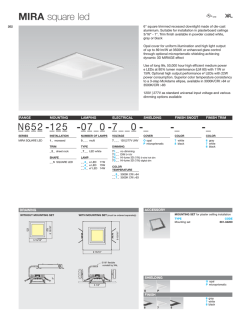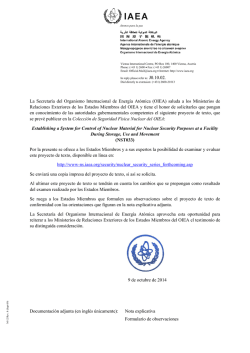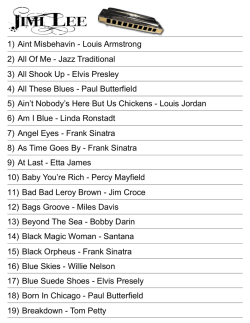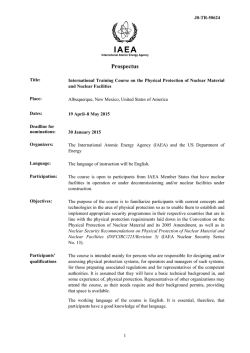
IAEA - ABFM
IAEA Training Material on Radiation Protection in Diagnostic and Interventional Radiology RADIATION PROTECTION IN DIAGNOSTIC AND INTERVENTIONAL RADIOLOGY L12: Shielding and X Ray room design IAEA International Atomic Energy Agency Introduction • Subject matter: the theory of shielding design and some related construction aspects. • The method used for shielding design and the basic shielding calculation procedure IAEA 12: Shielding and X Ray room design 2 Topics Equipment design and acceptable safety standards Use of dose constraints in X Ray room design Barriers and protective devices IAEA 12: Shielding and X Ray room design 3 Overview • To become familiar with the safety requirements for the design of X Ray systems and auxiliary equipment, shielding of facilities, and relevant international safety standards, e.g., IEC. IAEA 12: Shielding and X Ray room design 4 IAEA Training Material on Radiation Protection in Diagnostic and Interventional Radiology Part 12: Shielding and X Ray room design Topic 1: Equipment design and acceptable safety standards IAEA International Atomic Energy Agency Purpose of Shielding • To protect: • • • • the patients (when not being examined) the X Ray department staff visitors and the public persons working adjacent to or near the X Ray facility IAEA 12: Shielding and X Ray room design 6 Radiation Shielding - Design Concepts • Data required include consideration of: • • • • Type of X Ray equipment Usage (workload) Positioning Whether multiple tubes/receptors are being used • Primary beam access (vs. scatter only) • Operator location • Occupancy of Surrounding areas IAEA 12: Shielding and X Ray room design 7 Shielding Design (I) Equipment • What equipment is to be used? • General radiography • Fluoroscopy (with or without radiography) • Dental (oral, cephalometric, or OPG) • Mammography • CT IAEA 12: Shielding and X Ray room design 8 Shielding Design (II) The type of equipment is very important for the following reasons: • where the X Ray beam will be directed • the number and type of procedures performed • the location of the radiographer (operator) • the energy (kVp) of the X Rays IAEA 12: Shielding and X Ray room design 9 Shielding Design (III) Usage • Different X Ray equipment have very different usage. • For example, a dental unit uses low mAs and low (~70) kVp, and takes relatively few X Rays each week • A CT scanner uses high (~130) kVp, high mAs, and takes very many scans each week. IAEA 12: Shielding and X Ray room design 10 Shielding Design (IV) • The total mAs used each week is an indication of the total X Ray dose administered • The kVp used is also related to dose, but also indicates the penetrating ability of the X Rays • High kVp and mAs means that more shielding is required. IAEA 12: Shielding and X Ray room design 11 Shielding Design (V) Positioning • The location and orientation of the X Ray unit is very important: • distances are measured from the equipment (inverse square law will affect dose) • the directions the direct (primary) X Ray beam will be used depend on the position and orientation IAEA 12: Shielding and X Ray room design 12 Radiation Shielding - Typical Room Layout A to G are points used to calculate shielding IAEA 12: Shielding and X Ray room design 13 Shielding Design (VI) Number of X Ray tubes • Some X Ray equipment may be fitted with more than one tube • Sometimes two tubes may be used simultaneously, and in different directions • This naturally complicates shielding calculation IAEA 12: Shielding and X Ray room design 14 Shielding Design (VII) Surrounding areas • The X Ray room must be designed with knowledge of the location and use of all rooms which adjoin the X Ray room • Obviously a toilet will need less shielding than an office • Obtain a plan of the X Ray room and surroundings (including level above and below) IAEA 12: Shielding and X Ray room design 15 Radiation Shielding - Design Detail Must consider: • appropriate calculation points, covering all critical locations • design parameters such as workload, occupancy, use factor, leakage, target dose (see later) • these must be either assumed or taken from actual data • use a reasonable, worst case scenario (conservatively high estimates), since undershielding is worse than over-shielding IAEA 12: Shielding and X Ray room design 16 IAEA Training Material on Radiation Protection in Diagnostic and Interventional Radiology Part 12: Shielding and X Ray room design Topic 2: Use of dose constraints in X Ray room design IAEA International Atomic Energy Agency Radiation Shielding - Calculation • Based on NCRP Report No 147, Structural Shielding Design for Medical X-Ray Imaging Facilities (2004) • Assumptions used are conservative, so overshielding is common • Software is available, giving shielding in thickness of various materials IAEA 12: Shielding and X Ray room design 18 Radiation Shielding Parameters (I) P - design dose per week • usually based on 5 mSv per year for occupationally exposed persons (25% of dose limit), and 1 mSv for public • occupational dose must only be used in controlled areas, i.e., for radiographers, radiologists, and other radiation workers IAEA 12: Shielding and X Ray room design 19 Radiation Shielding Parameters (II) • Film storage areas (darkrooms) need special consideration • Long periods of exposure will affect film, but much shorter periods (i.e., lower doses) will fog film in cassettes • A simple rule is to allow 0.1 mGy for the period the film is in storage - if this is 1 month, the design dose is 0.025 mGy/week IAEA 12: Shielding and X Ray room design 20 Radiation Shielding Parameters (III) • Remember we must shield against three sources of radiation • In decreasing importance, these are: • scattered radiation (from the patient) • primary radiation (the X Ray beam) • leakage radiation (from the X Ray tube) IAEA 12: Shielding and X Ray room design 21 Radiation Shielding Parameters (IV) U - use factor • fraction of time the primary beam is in a particular direction i.e.: the chosen calculation point • must allow for realistic use • for all points, sum may exceed 1 IAEA 12: Shielding and X Ray room design 22 Radiation Shielding Parameters (V) • For some X Ray equipment, the X Ray beam is always stopped by the image receptor, thus the use factor is 0 in other directions, e.g., CT, fluoroscopy, mammography • For general radiographic and fluoroscopic equipment the primary beam is usually intercepted by the image detector • This reduces shielding requirements IAEA 12: Shielding and X Ray room design 23 Radiation Shielding Parameters (VI) • For radiography, there will be certain directions where the X Ray beam will be pointed: • towards the floor • across the patient, usually only in one direction • toward the chest Bucky stand • The type of tube suspension will be important, e.g.: ceiling mounted, floor mounted, C-arm etc. IAEA 12: Shielding and X Ray room design 24 Radiation Shielding Parameters (VII) T - Occupancy • T = fraction of time a particular place is occupied by staff, patients or public • Has to be conservative • Ranges from 1 for adjacent offices and work areas, to 1/20 for public toilets and 1/40 for outdoor areas with transient traffic IAEA 12: Shielding and X Ray room design 25 Occupancy (NCRP 147) Area Work areas, offices, staff rooms Occupancy 1 Corridors 1/5 Toilets, unattended waiting rooms 1/20 Outdoor areas with transient traffic 1/40 IAEA 12: Shielding and X Ray room design 26 Radiation Shielding Parameters (VIII) W - Workload • A measure of the radiation output in one week • Measured in mA-minutes • Varies greatly with assumed maximum kVp of X Ray unit • Usually a gross overestimation • Actual dose/mAs can be estimated IAEA 12: Shielding and X Ray room design 27 Workload (I) • For example: a general radiography room • The kVp used will be in the range 60-120 kVp • The exposure for each film will be between 5 mAs and 100 mAs • There may be 50 patients per day, and the room may be used 7 days a week • Each patient may have between 1 and 5 films SO HOW DO WE ESTIMATE W ? IAEA 12: Shielding and X Ray room design 28 Workload (II) • Assume an average of 50 mAs per film, 3 films per patient • Thus W = 50 mAs x 3 films x 50 patients x 7 days = 52,500 mAs per week = 875 mA-min per week • We could also assume that all this work is performed at 100 kVp IAEA 12: Shielding and X Ray room design 29 Examples of Workloads Weekly Workload (W) mA-min at: 100 kVp 125 kVp General Radiography Fluoroscopy (including spot films) Chiropractic Mammography Dental 150 kVp 1,000 400 200 750 300 150 1,200 500 250 700 at 30 kVp (1,500 for breast screening) 6 at 70 kVp (conventional intra-oral films) For more realistic values and CT see NCRP 147 IAEA 12: Shielding and X Ray room design 30 Workload - CT • CT workloads are best calculated from NCRP 147 • Remember that new spiral CT units, or multislice CT, could have higher workloads • A typical CT workload is about 28,000 mAmin per week IAEA 12: Shielding and X Ray room design 31 Tube Leakage • All X Ray tubes have some radiation leakage there is only 2-3 mm lead in the housing • Leakage is limited in most countries to 1 mGy hr-1 at 1 meter, so this can be used as the actual leakage value for shielding calculations • Leakage is specified at the maximum rated continuous tube current, which is about 3-5 mA at 150 kVp for most radiographic X Ray tubes IAEA 12: Shielding and X Ray room design 32 Radiation Shielding Parameters IAEA 12: Shielding and X Ray room design 33 Room Shielding - Multiple X Ray Tubes • Some rooms will be fitted with more than one X Ray tube (maybe a ceiling-mounted tube, and a floor-mounted tube) • Shielding calculations MUST consider the TOTAL radiation dose from the two tubes IAEA 12: Shielding and X Ray room design 34 IAEA Training Material on Radiation Protection in Diagnostic and Interventional Radiology Part 12: Shielding and X Ray room design Topic 3: Barriers and protective devices IAEA International Atomic Energy Agency Shielding - Construction I Materials available: • Lead sheet brick • gypsum or high Z plasterboard • concrete block • leaded glass or acrylic IAEA 12: Shielding and X Ray room design 36 Shielding - Construction Problems Some problems with shielding materials: • Brick walls - mortar joints • Use of lead sheets nailed to timber frame • Lead inadequately bonded to backing • Joints between sheets with no overlap • Use of hollow core brick or block • Use of plate glass where lead glass specified IAEA 12: Shielding and X Ray room design 37 Problems in shielding - Brick Walls & Mortar Joints • • • • Bricks should be solid and not hollow Bricks have very variable X Ray attenuation Mortar is less attenuating than brick Mortar is often not applied across the full thickness of the brick IAEA 12: Shielding and X Ray room design 38 Problems in shielding - Lead inadequately bonded to backing • Lead must be fully glued (bonded) to a backing such as wood or wallboard • If the lead is not properly bonded, it may peel off after a few years • Not all glues are suitable for lead (oxidization of the lead surface) IAEA 12: Shielding and X Ray room design 39 Problems in shielding - Joins between sheets with no overlap • There must be 10 - 15 mm overlap between adjoining sheets of lead • Without an overlap, there may be relatively large gaps for the radiation to pass through • Corners are a particular problem • Penetrations for electrical boxes and ducts are of concern IAEA 12: Shielding and X Ray room design 40 Problems in shielding - Use of plate glass • Leaded glass or acrylic should be used for windows • Laminated layers of plate glass can be used where radiation levels are low, e.g., for the wall at the foot of a CT scanner IAEA 12: Shielding and X Ray room design 41 Radiation Shielding - Construction II • Continuity and integrity of shielding very important • Problem areas: • joints • penetrations in walls and floor • window frames • doors and frames IAEA 12: Shielding and X Ray room design 42 Penetrations • “Penetrations” means any hole cut into the lead for cables, electrical connectors, pipes etc. • Unless the penetration is small (~2-3 mm), there must be additional lead over the hole, Nails and screws used to fix bonded lead sheet to a wall do not require covering IAEA 12: Shielding and X Ray room design 43 Window frames • The lead sheet fixed to a wall must overlap any lead glass window fitted • It is common to find a gap of up to 5 cm, which is unacceptable IAEA 12: Shielding and X Ray room design 44 Shielding of Doors and Frames IAEA 12: Shielding and X Ray room design 45 Shielding - Verification I • Verification of appropriate thickness and proper installation • • • • • is mandatory Two choices - visual or measurement Visual check (preferred) must be performed before shielding covered - the actual lead thickness can be measured easily Radiation measurement necessary for window and door frames etc. Isotope source simplifies measurements Measurement for walls very slow IAEA 12: Shielding and X Ray room design 46 Shielding Testing IAEA 12: Shielding and X Ray room design 47 Records • It is very important to keep records of shielding calculations, as well as details of inspections and corrective action taken to fix faults in the shielding • In 5 years, it might not be possible to find anyone who remembers what was done! • Shielding records should become a permanent part of the facility engineering records; a copy should be stored in the room (consider a permanent plaque on the wall in the room specifying the amount of shielding in each wall); and a copy should be retained by the medical physicist doing the calculations IAEA 12: Shielding and X Ray room design 48 Summary • The design of shielding for an X Ray room is a relatively complex task, but can be simplified by the use of some standard assumptions • Record keeping is essential to ensure traceability and constant improvement of shielding according to both practice and equipment modification IAEA 12: Shielding and X Ray room design 49 Where to Get More Information (I) • Radiation shielding for diagnostic X Rays. BIR report (2000) Ed. D.G. Sutton & J.R. Williams • National Council on Radiation Protection and Measurements, Report No. 147, “Structural Shielding Design for Medical XRay Imaging Facilities” Bethesda, MD 2004. IAEA 12: Shielding and X Ray room design 50
© Copyright 2026






